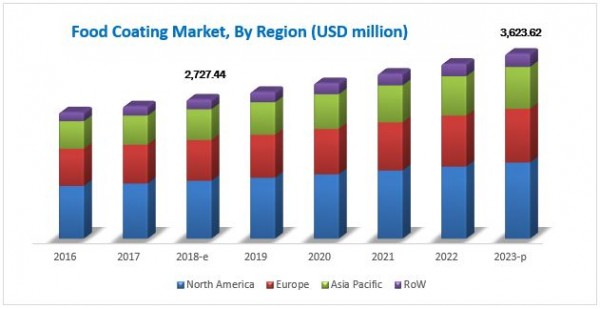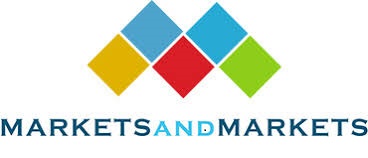The report “Food Coating Market by Ingredient Type (Batter, Flours), Application (Bakery, Snacks), Equipment Type (Coaters & Applicators, Enrobers), Form (Dry, Liquid), Mode of Operation (Automatic, Semi-Automatic), and Region – Global Forecast to 2023″, The food coating ingredients and equipment markets are estimated to be valued at USD 2.73 billion and USD 1.93 billion, respectively, in 2018 and are projected to reach USD 3.62 billion and USD 2.31 billion, respectively, by 2023, at a CAGR of 5.8% and 3.7% from 2018 to 2023. The market is driven by factors such as rising demand for meat & seafood, poultry, bakery products, and confectionery products, growing demand for processed & convenience food, increased focus on production efficiency, processing time, and quality of food products, growing demand for innovative food coating products due to changing consumer trends.

Download PDF Brochure: https://www.marketsandmarkets.com/pdfdownloadNew.asp?id=168532529
Growing food processing in meat, bakery, snacks, and breakfast cereal
Meat, snacks, bakery products, and breakfast cereal are some of the major applications of food coating ingredients and equipment. The fast changing and busy lifestyles of consumers due to rapid urbanization have also led to a high demand for ready-to-eat and ready-to-cook meat, confectionery products, and bakery food products as they are processed food products that require less time and effort to cook, while also ensuring nutrition and durability. Furthermore, rising inclination of consumers toward protein-based food products, popularity of frozen food, and the growing frequency of snacking are driving the demand for these products in the market, leading to the growth in demand for ingredients such as spices, fats and oils, cocoa, flours, and sugar and syrups. As a result, the demand of equipment such as coaters, applicators, and enrobers is also expected to rise.
Rising costs of production due to fluctuating ingredient prices
Rising prices of ingredients and their subsequent fluctuations have emerged as key restraints in food coating. The high cost of ingredients has led to high production cost, which further hinders the chances of adoption of new coating technologies by the manufacturer due to the resultant lower margins and longer time taken to attain breakeven point for food manufacturers. The food coating equipment must thus offer cost effectiveness in terms of output and ingredient usage to make up for the rising ingredient prices and make it easier for food manufacturers to achieve economies of scale. For instance, the prices of cocoa beans and sugar, which are the major ingredients used in coating confectionery, chocolates, and snacks increased continuously between 2013 and 2016, leading to high cost of the end product, which, in turn, leads manufacturers to focus on cutting cost, rather than investments on new technologies or equipment in their manufacturing facilities.
Growing investment opportunities in the development of new food coating technology
There has been a growing awareness among consumers for various food trends due to globalization. Food manufacturing companies have also been expanding their presence across the globe due to the liberalization of trade. New and untapped markets are being explored by food manufacturers, wherein even domestic players are developing their product offerings to meet the rising competition in the market. For instance, manufacturers in China, India, and Japan have developed their own food coating equipment that are as good as the imported equipment or the equipment supplied by the market leaders in coating technology. To get an edge over competitors in both domestic and international markets, companies are focusing on innovating their food coating technology offerings through innovative technologies, such as electrostatic coating, which offers 98% coating of all products, making it an even more efficient coating than traditional flavorings methods.
To cater to the changing demand from food manufacturers, food coating equipment manufacturers are also focusing on the R&D of various technologies used in equipment. The key features required by food manufacturers include better and large-scale handling of food products, increasing the shelf life of products, improved production capacity, and reducing the wastage of ingredients.
This report includes estimations of the market size in terms of value (USD million). Both, top-down and bottom-up approaches were used to estimate and validate the size of the global food coating market and to estimate the size of various other dependent submarkets in the overall market. The key players in the market have been identified through secondary research, some of the sources are press releases, paid databases such as Factiva and Bloomberg, annual reports, and financial journals; their market share in respective regions has also been determined through primary and secondary research. All percentage shares, splits, and breakdowns have been determined using secondary sources and were verified through primary sources. The figure below shows the breakdown of profiles of industry experts who participated in primary discussions.
Speak to Analyst: https://www.marketsandmarkets.com/speaktoanalystNew.asp?id=168532529
North America is estimated to dominate the food coating ingredient market in 2018.
North America is expected to continue its dominant presence in the food coating ingredients market during the forecast period. The region is backed by superior food coating technologies and utilizes automatic equipment for coating food ingredients. Consumers in the US and Canada majorly consume salty snacks such as potato chips, which need dry coating. Apart from this, these countries consume frozen food that requires coating for an extended shelf life. Consumers in this region opt for cereal as breakfast options where coating is applied. The US is also a huge market for confectionery products. These factors have fueled the growth of the food coating market in North America.
This report includes a study of marketing and development strategies, along with the product portfolios of the leading companies. It includes profiles of leading companies such Marel (Iceland), GEA Group (Germany), Bühler AG (Switzerland), JBT Corporation (US), TNA Australia Pty Limited (Australia), Clextral (France), Dumoulin (France), Spice Application Systems (UK), Cargill (US), Kerry Group (Iceland), Tate & Lyle Plc (UK), Newly Weds Foods (US), PGP International (US), Archer Daniels Midland Company (US), Ingredion Incorporated (US), and Bowman Ingredients (UK).
Media Contact
Company Name: MarketsandMarkets
Contact Person: Mr. Shelly Singh
Email: Send Email
Phone: 1-888-600-6441
Address:630 Dundee Road Suite 430
City: Northbrook
State: IL
Country: United States
Website: https://www.marketsandmarkets.com/Market-Reports/food-coating-ingredients-market-168532529.html

